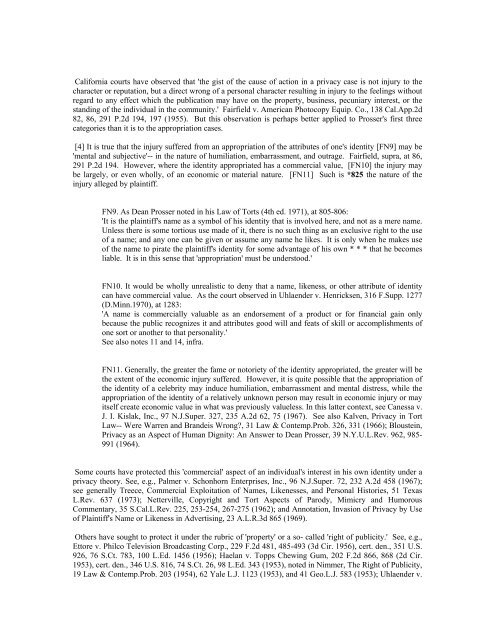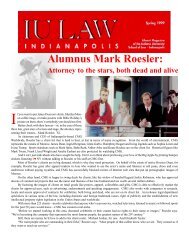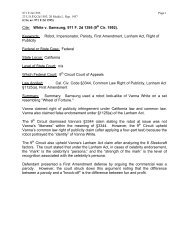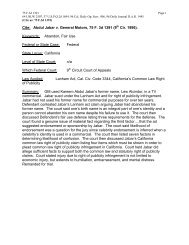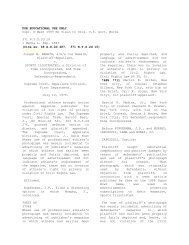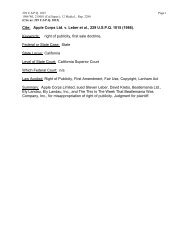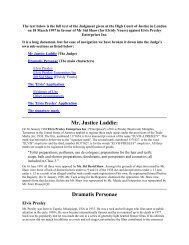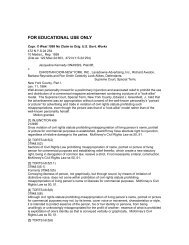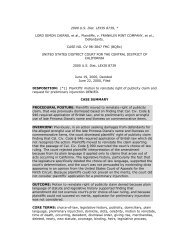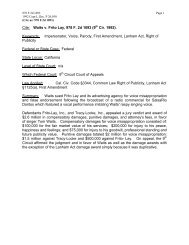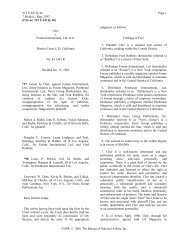Motschenbacher v. R.J. Reynolds Tobacco Company - Mark Roesler
Motschenbacher v. R.J. Reynolds Tobacco Company - Mark Roesler
Motschenbacher v. R.J. Reynolds Tobacco Company - Mark Roesler
Create successful ePaper yourself
Turn your PDF publications into a flip-book with our unique Google optimized e-Paper software.
California courts have observed that 'the gist of the cause of action in a privacy case is not injury to thecharacter or reputation, but a direct wrong of a personal character resulting in injury to the feelings withoutregard to any effect which the publication may have on the property, business, pecuniary interest, or thestanding of the individual in the community.' Fairfield v. American Photocopy Equip. Co., 138 Cal.App.2d82, 86, 291 P.2d 194, 197 (1955). But this observation is perhaps better applied to Prosser's first threecategories than it is to the appropriation cases.[4] It is true that the injury suffered from an appropriation of the attributes of one's identity [FN9] may be'mental and subjective'-- in the nature of humiliation, embarrassment, and outrage. Fairfield, supra, at 86,291 P.2d 194. However, where the identity appropriated has a commercial value, [FN10] the injury maybe largely, or even wholly, of an economic or material nature. [FN11] Such is *825 the nature of theinjury alleged by plaintiff.FN9. As Dean Prosser noted in his Law of Torts (4th ed. 1971), at 805-806:'It is the plaintiff's name as a symbol of his identity that is involved here, and not as a mere name.Unless there is some tortious use made of it, there is no such thing as an exclusive right to the useof a name; and any one can be given or assume any name he likes. It is only when he makes useof the name to pirate the plaintiff's identity for some advantage of his own * * * that he becomesliable. It is in this sense that 'appropriation' must be understood.'FN10. It would be wholly unrealistic to deny that a name, likeness, or other attribute of identitycan have commercial value. As the court observed in Uhlaender v. Henricksen, 316 F.Supp. 1277(D.Minn.1970), at 1283:'A name is commercially valuable as an endorsement of a product or for financial gain onlybecause the public recognizes it and attributes good will and feats of skill or accomplishments ofone sort or another to that personality.'See also notes 11 and 14, infra.FN11. Generally, the greater the fame or notoriety of the identity appropriated, the greater will bethe extent of the economic injury suffered. However, it is quite possible that the appropriation ofthe identity of a celebrity may induce humiliation, embarrassment and mental distress, while theappropriation of the identity of a relatively unknown person may result in economic injury or mayitself create economic value in what was previously valueless. In this latter context, see Canessa v.J. I. Kislak, Inc., 97 N.J.Super. 327, 235 A.2d 62, 75 (1967). See also Kalven, Privacy in TortLaw-- Were Warren and Brandeis Wrong?, 31 Law & Contemp.Prob. 326, 331 (1966); Bloustein,Privacy as an Aspect of Human Dignity: An Answer to Dean Prosser, 39 N.Y.U.L.Rev. 962, 985-991 (1964).Some courts have protected this 'commercial' aspect of an individual's interest in his own identity under aprivacy theory. See, e.g., Palmer v. Schonhorn Enterprises, Inc., 96 N.J.Super. 72, 232 A.2d 458 (1967);see generally Treece, Commercial Exploitation of Names, Likenesses, and Personal Histories, 51 TexasL.Rev. 637 (1973); Netterville, Copyright and Tort Aspects of Parody, Mimicry and HumorousCommentary, 35 S.Cal.L.Rev. 225, 253-254, 267-275 (1962); and Annotation, Invasion of Privacy by Useof Plaintiff's Name or Likeness in Advertising, 23 A.L.R.3d 865 (1969).Others have sought to protect it under the rubric of 'property' or a so- called 'right of publicity.' See, e.g.,Ettore v. Philco Television Broadcasting Corp., 229 F.2d 481, 485-493 (3d Cir. 1956), cert. den., 351 U.S.926, 76 S.Ct. 783, 100 L.Ed. 1456 (1956); Haelan v. Topps Chewing Gum, 202 F.2d 866, 868 (2d Cir.1953), cert. den., 346 U.S. 816, 74 S.Ct. 26, 98 L.Ed. 343 (1953), noted in Nimmer, The Right of Publicity,19 Law & Contemp.Prob. 203 (1954), 62 Yale L.J. 1123 (1953), and 41 Geo.L.J. 583 (1953); Uhlaender v.


